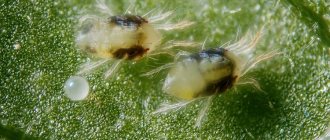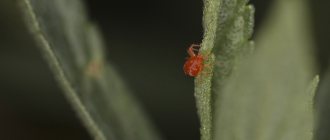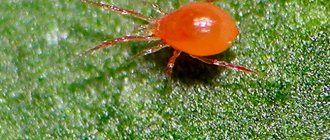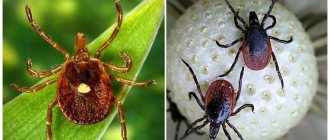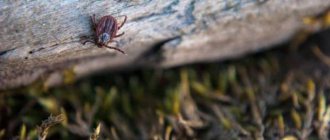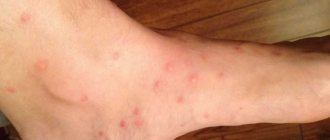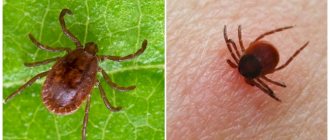Spider mites are a frequent and not the most pleasant guest in the house. In order to live and reproduce, this parasite is ideally suited to the conditions of an ordinary apartment where there are plants.
The well-known house ficus suffers greatly from this species.
Spider mites on ficus are extremely insidious; the first signs of infection are quite difficult to see, since they appear on the back of the leaves and the trunk of the ficus, later the plant begins to lose its bright green hue, and in the late stage a web appears. Why do spider mites appear on ficus? How to fight? Is it possible to get rid of the parasite? Let's try to figure it out.
How to get rid of spider mites on ficus, remedies
How to deal with spider mites on a ficus if an infection does occur?
Let's look at each of them in detail.
- Spraying ficus with chamomile infusion. The recipe is simple: 1 tablespoon per liter of water, cool to room temperature and spray the plant with a small amount of infusion.
- Garlic tincture. A similar method, but more labor-intensive. This time we cut two heads of garlic into small slices, add a liter of water, put the tincture under the bed for 5 days, then mix it evenly with water and spray the ficus.
- Rubbing alcohol can also be a great help in controlling spider mites on your ficus benjamina. Blot each leaf with ordinary cotton wool and the tick will die! But the main disadvantage of this method is that the laid eggs will remain, and therefore, this will only alleviate the condition of the plant, but will not cure the disease completely.
- Soap “bath”. For this method, it is necessary to apply a thin layer of foam to the ficus, then leave it in this state for 4 hours, rinse off the foam and cover with a plastic bag for a day.
If you don’t particularly trust traditional methods and are willing to pay for a good remedy to combat spider mites, then chemical treatment is suitable for you. Everything is simple here, choose a product and treat the ficus with it according to the instructions.
- Actellik is a powerful chemical; it is recommended to use it only outdoors.
- Fitoverm is a gentle option, but you should not allow the chemical to come into contact with exposed skin; if this happens, wash thoroughly and change your clothes.
- Alatar, Intavir, Neoron, Apollo, Vermitek are excellent analogues of the above-mentioned products.
Ficus benjamina: pests, control measures and prevention
Plants from the genus Ficus, the Mulberry family, have been used by humans since time immemorial. The leaf of the fig or fig, one of the types of ficus, has been depicted many times by artists of all times, and the fig itself is a valuable food product. Many species of ficus are valued as rubber plants. Ficus leaves are used in medicine.
Ficus trees grow mainly in warm climates of the tropics and subtropics. Due to their attractive appearance, they have become popular indoor plants. One of them is ficus benjamina, the pests of which and measures to combat them will be discussed below.
Mealybugs on ficus, control measures
Very often, ficus benjamina leaves begin to turn yellow, dry out and fall off. If this is not due to errors in care or moving the flower to another place, then perhaps the reason for this phenomenon is damage to the plant by mealybugs. To detect the pest, you need to inspect the leaves and stems of the ficus.
It is not difficult to spot the pest. His body is shrouded in a whitish substance - powdery wax. It looks like cotton wool or felt. The plant is harmed by females and larvae. Infection is indicated not only by the appearance of white cocoons, but also by the flow of white juice from damaged leaf blades or stems. In this case, the surface becomes sticky.
If measures are not taken immediately, the pest can cause not only individual leaves to dry out, but also shoots to stop growing, and then the death of the entire plant.
The reproduction rate of this dangerous pest is enormous; one female, whose body length is on average 3-5 mm, lays up to 600 eggs. They are also in a soft white cocoon. The process of laying eggs lasts about two weeks, after which the females die.
Young individuals begin to actively feed on plant juices, white threads appear around them and reproduction repeats. At temperatures above 24 degrees and high humidity, scale insects grow and reach sexual maturity very quickly.
It is very difficult to fight insects; cocoon fibers protect insects from direct exposure to insecticides. In addition, scale insects adapt very quickly to the products used. In the initial stage of the lesion, you can use traditional methods:
- first wash the leaves with added soap
- then rinse them with running water
- sprinkle with infusion of tangerine or lemon peels
More serious measures to combat this pest are as follows:
- radical pruning of all parts of the plant affected by scale insects
- two - three times treatment of the plant with the preparations “Decis”, “Karbofos” according to the instructions for the drug; in severe cases, the damaged parts are cut out before spraying
The main prevention is compliance with quarantine after acquiring new plants. Even purchased bouquets should not be placed next to indoor flowers.
How to deal with scale insects on ficus benjamina
Scale insects are as serious pests for ficus plants as scale insects. Scale insects are dangerous because they can go unnoticed for a very long time.
Due to the hard skin shield with a waxy coating covering the insect from above, and the tightest possible fit to parts of the plant, it is almost impossible to destroy it in adulthood using insecticides. The favorite places to place scale insects on ficus are:
- bottom of sheet
- trunk
- place where petioles attach to the trunk
If infested seriously, scale insects can seriously damage the plant and actually destroy it. A sign of such a lesion may be the appearance of sticky liquid on the leaf blades. Sometimes there is so much of it that it drips from the leaves. Measures to combat scale insects begin with the mechanical removal of adult individuals by hand.
Using a small stiff brush will make the process easier. You can also use a toothbrush. Manual cleaning is only effective at an early stage. If time is lost, you need to act more radically. To do this you need:
- isolate infected ficus
- remove all adult scale insects that you can see
- cut off the most infected leaves
- spray the plant with actara solution
- every other day, spray the ficus again
- after seven days, carry out a third spraying
about pests of ficus benjamina:
Important! In the summer, it is more convenient to inspect and treat the plant outdoors in good sunlight. Regular careful inspection of the ficus is a good prevention of scale insects infection. The presence of a magnifying glass will increase the reliability of external inspections.
Measures to combat spider mites on ficus benjamina
Spider mites are dangerous because they cannot be destroyed at once. If a thin cobweb becomes noticeable on the ficus trunk, then this is a sure sign of the appearance of a spider mite. In severe cases, the plant may be completely entangled in cobwebs.
If detected in a timely manner, it is enough to wash the leaves and shoots of the ficus with soap. After this, leave the plant for three hours and rinse off the solution. Cover the ficus with a bag for a day. The following chemicals will help get rid of spider mites:
Treatment with these drugs is carried out according to the instructions in compliance with safety measures. Superstitious people unfairly consider ficus unsuitable for growing in residential premises. Actually this is not true. Ficus not only cleans the air well from dust and pollution, but also reduces the number of pathogenic microbes. Therefore, the presence of ficus Benjamin in the house will significantly improve the microclimate inside it.
Source: https://OgorodSadovod.com/entry/3210-fikus-bendzhamina-vrediteli-mery-borby-s-nimi-i-profilaktika
Prevention
Treatment may not be necessary at all if you take care of the health of your plant in time, so good prevention of ficus is necessary. Preventing ficus is very simple and does not require much time, here are some of the methods:
- Once every two weeks, wipe each area of the ficus with a damp sponge, and spray the plant with water every two days, because the main enemy of the mite is moisture.
- In the summer, pay closer attention to the plant and check its stem and leaves for parasites as often as possible.
- When bringing new flowers home, check them well for the presence of insects, and flowers from the street should not be brought close to domestic species.
- Do not open windows and doors for long periods of time on warm days.
Spider mites quite often infect indoor plants, and if this pest is not eliminated in time, the plants may die. How to determine that Benjamin's ficuses are infected with mites, how to deal with these parasites, and what to do to prevent their occurrence, read the article.
Signs and consequences of infection
Spider mites appear on ficus benjamina as follows:
- Initially, the lesion can be noticed on the trunk of the plant - areas affected by a thin whitish web appear on it. Once you have noticed even a relatively small area covered in cobwebs, it is worth inspecting the entire ficus. The pest itself is quite small in size and can only be seen using optical instruments.
- The pest then attacks the leaves. They begin to change color from green to marbled, this may appear in small spots, then the affected area increases. The leaves cease to receive sufficient nutrition, soon turn yellow, and then completely fall off.
- The next sign may be a slowdown in the growth of the plant ; outwardly it ceases to look healthy, and if you do not take action, the ficus will simply die.
These photos show how spider mites manifest themselves on ficus:
How to deal with spider mites on ficus?
Spider mites are a frequent and not the most pleasant guest in the house. In order to live and reproduce, this parasite is ideally suited to the conditions of an ordinary apartment where there are plants.
The well-known house ficus suffers greatly from this species.
Spider mites on ficus are extremely insidious; the first signs of infection are quite difficult to see, since they appear on the back of the leaves and the trunk of the ficus, later the plant begins to lose its bright green hue, and in the late stage a web appears. Why do spider mites appear on ficus? How to fight? Is it possible to get rid of the parasite? Let's try to figure it out.
Spider mites on ficus benjamina: how to fight
Spider mites can be combated not only with chemicals, but also with biological agents or traditional methods. Biologists note that this is a long process; after a single treatment, the pest cannot be exterminated, so be prepared to repeatedly use several products.
Chemicals
- Actellik - suitable if you have several ficus trees, and all of them have been infected by a pest. To process the plants, you need to take them out of the room into an open space or carry out the procedure in a well-ventilated area.
- Fitoverm - suitable for indoor processing. But after its completion, you need to wash thoroughly in the shower, rinse your mouth, change clothes, and wash your clothes immediately.
- Neoron is an effective remedy. To destroy the pest, double treatment will be sufficient. It destroys not only adults, but also eggs.
- There are also other remedies that will help with plant infection. These include Apollo, Aktofit, Fufanon, Vermitek and others like that.
Biological agents
These products contain predatory mites that eat spider mites directly on the plant. This drug is available for purchase only in flower shops or on the Internet.
- Amblyseius;
Traditional methods
These are the products that cannot be bought in pharmacies or specialized stores; they are used by experienced flower growers. According to their reviews, these remedies really help get rid of the problem.
- Medical alcohol. There will be no harm to the leaves if they are wiped with medical alcohol, but such a solution is harmful to the parasite. But only adult ticks can die, but alcohol will not affect the eggs; it is better to choose another method.
- Soap. Soapy water is also harmful to the pest. Before this method of processing, the plant along with the pot must be placed in a large basin or bathtub. Apply the soap solution to a sponge and thoroughly wipe the leaves, ficus trunk, pot and the place where the plant is constantly located. The soil also needs to be treated. Then leave the solution on the ficus for several hours, then rinse thoroughly, and cover the flower with a dry bag for about a day, and then remove.
- Onion peel. To prepare such a product, you need to take 100 grams of onion peel, pour 5 liters of water into it, leave for 5 days, then strain, pour into a spray bottle and spray the plant.
- Garlic. Peel two heads of garlic, grind them on a grater or blender, add 1 liter of water and leave for 4-5 days, but for this you need to choose a place protected from sunlight. Then dilute the solution with water in a ratio of 1 to 1 and also apply it to the plant damaged by the pest using a sprayer.
- Chamomile. Dried chamomile flowers can be bought at any pharmacy. Prepare an infusion: pour 1 tablespoon with 1 liter of boiled water, let it brew, then cool and spray the ficus with the resulting infusion.
How to deal with spider mites on ficus
When fighting spider mites, it is important to constantly maintain high humidity around the vegetative organs of the crop. Ficus is regularly sprayed or placed close to an ultrasonic humidifier.
If a pest is detected, the plant is immediately bathed in the shower and treated with a preparation with an acaricidal effect.
In order to get rid of spider mites, you will need 3 or more treatments with alternating medications. Using different acaricides at weekly intervals will prevent the development of resistance in the phytophage.
The frequency of treatments largely depends on the room temperature. At +20 degrees, ficus is treated against spider mites once every 7-10 days for a month; at +30 and above, the preparations are applied to the leaves every 4 days for 3 weeks.
Treatment with drugs
The following preparations are used among acaricides of chemical origin:
Anti-mite belongs to hazard class 3. The active ingredient is malathion. Active against adults. Cannot be used simultaneously with other acaricides.
Akarin is a broad-spectrum drug based on avertin, hazard class 3. Kills only mature ticks. Not effective against eggs and larvae of the pest.
Apollo is a systemic acaricide that has a detrimental effect on both adults and their larvae. Inhibits the development of ticks at early mobile stages. Can be combined with other acaricides. Refers to low-hazard substances for humans and animals. Toxic to fish. It has an acaricidal effect due to clofenkisine.
Alatar is a drug based on malathion and cypermethrin, hazard class 3. It has a synergistic effect, i.e., the components included in the composition enhance each other’s effect.
Actellik is one of the old proven remedies against spider mites. But due to the high hazard class (class 2), it must be used at home with great caution. The active component of the chemical agent is pirimiphos-methyl of non-systemic action.
Vermitek shows effectiveness against tick larvae and adult ticks. The action is due to abamectin. Belongs to hazard class 2
Sunmite is highly effective at all stages of spider mite development. Unlike the above drugs, it does not have a pungent odor. The active substance is pyradaben.
Oberon Rapid is destructive to ticks at all stages of its development. It contains 2 active ingredients: spiromesifen and abamectin. Has a slight specific odor.
Treatment of ficus against spider mites is also carried out using the biological drug Fitoverm. The active ingredient is aversectin.
Fitoverm shows the greatest effectiveness in combination with the drug Nissoran. The second drug exhibits acaricidal activity due to hexythiazox. It has a destructive effect on the larvae, eggs and nymphs of the pest, but is practically ineffective at the adult stage.
It is advisable to carry out treatment with any type of acaricide on a balcony with open windows or on the street. As protective equipment, you must use gloves, goggles, a respirator or a medical mask.
Useful video
This video explains how to deal with spider mites and other pests of Ficus Benjamin:
Spider mites on ficus are a problem that any gardener may encounter. Often the fight against this pest is not easy, and it does not disappear after the first treatment with one or another substance. If cobwebs appear on a plant, what to do - take action immediately and prepare for a long treatment process.
In order for it to be as short as possible, you should know what the signs of damage to a home tree are and how to deal with them. At the first alarming symptoms, measures should be taken immediately, since constant parasitism of the mite on the plant will inevitably lead to its rapid death.
Treatment of ficus with chemicals
Despite the seriousness of the disease, at the first signs of it, the ficus can be saved. There are several methods that will help remove spider mites on a ficus tree. Each gardener decides how to fight it independently. Depending on how severely the plant is affected by the mite, chemical or folk remedies are suitable for its treatment.
It makes sense to use chemicals in cases where most of the leaf crown is damaged on the inside, new shoots are not growing, and the appearance indicates a serious degree of disease. A large population of pests is destroyed only with the help of specially developed chemical insecticidal preparations. These include:
They should be used in strict accordance with the instructions, which contain clear recommendations regarding how often and in what doses the product is allowed to be used. For example, after treatment with Neoron and Fitoverm, the room must be ventilated. Aktellik is approved for use only outdoors. Its use in a closed room will lead to poisoning of people and animals in it.
As an alternative to insecticides, you can choose biological products such as Phytoseiulus and Amblyseius. New generation substances make it possible to fight spider mites at the expense of other insects that lead a predatory life and eat adult parasites, their eggs and larvae. As all parasitic individuals are destroyed, insect predators will die due to lack of food.
What does a spider mite look like?
Mites on ficus trees are not so easy to detect. Even adult insects are too small, about 0.6 millimeters in size. However, if you take an ordinary magnifying glass, the pest becomes clearly visible. It has an oval shape, and small hairs grow on its body. Thanks to them, the insect tenaciously sits on the plant, which allows it to constantly suck the juice out of it.
Female ticks are larger than males, and all individuals have four pairs of legs. The color is brownish or green, and their feeding organ is the proboscis. A distinctive feature of the pest is that its eggs, even in the harshest conditions, can survive in the ground for up to five years. This is precisely the main reason why it can be difficult to remove them completely, although at home the presence of closed soil in a pot greatly simplifies the task.
What does a pest look like?
Inexperienced gardeners notice spider mites when the infestation is widespread and the consequences of its activity are difficult to miss. It is not always possible to see the pest itself with the naked eye.
Enlarged photo of the pest
The size of the phytophage body varies from 0.3 to 0.6 mm. It is easier to detect ticks from early autumn to spring, when females change their grayish-green color to a brighter one. During this period, the pest looks like small dots of red or red-orange color (see photo).
Mites on ficus most often settle on the inside of the leaves. The lower part of the leaf plate is more vulnerable and it is easier for the pest to bite through it.
Signs of ficus damage by spider mites
Mites on ficus live in large colonies and settle on leaves and other organs of the tree in large quantities. Most often these are the back sides of the leaves. As you know, the foliage of a healthy plant is dense and elastic, and the branches are powerful and thick. However, if he is overcome by a parasite, the picture immediately begins to change dramatically.
First, the pest “captures” the trunk, entwining it with a web, which is barely noticeable in the initial stages of the attack. Gradually, along the web, it makes its way to the leaves, and a characteristic marble pattern begins to appear on them, directly indicating an attack by ticks and that their population is rapidly increasing.
Most often, cobwebs can be found on the back of leaves. In severe cases, the leaves die off as the parasite drains the juice from them. The growth and development of the tree stops, the buds dry out, and it begins to shed not only foliage, but also branches. The trunk becomes completely bare.
Chemical insecticides in the fight against spider mites
Spider mites on ficus and how to fight them, if the damage is total and the insects have already multiplied throughout the plant, you should not even doubt whether it is worth using chemical insecticides. In advanced cases, folk remedies will not provide adequate assistance. They are effective only for local damage and minor insect spread. At the present stage, there are not only well-known chemical preparations, but also substances of biological origin that can destroy not only mature mites, but also their larvae and laid eggs. In flower shops there is always the opportunity to purchase several popular products. These are Actellik, Alatar, Intavir, Neoron and many others. Also, we should not forget about the “good old” karbofos.
Before purchasing, you should consult in detail with the seller about a particular product, since each of them has a certain toxicity class. You should also carefully study the instructions for use, which describe in detail all the information about the drug. For example, Actellik is very toxic, and treatment should be carried out only in a well-ventilated area, as both people and pets can be poisoned. It is recommended to use Actellik only in the summer, and before treatment, take the pot with the “patient” out into the open air or onto a balcony and spray only there.
How to effectively fight spider mites on ficus
The fact that a spider mite has infested a ficus becomes known only when the pest has already multiplied significantly and traces of its vital activity are visible.
This insect is very small, it is not easy to see single individuals. What to do if a spider mite is found on a ficus, how to fight the parasite, and what will be the consequences of not taking timely measures to destroy it?
How to detect a pest on a ficus
Why does the tick so often go unnoticed? This is because its body barely reaches a millimeter in length. Such a tiny insect is quite harmless until it reproduces. And ticks reproduce amazingly quickly. The female lays up to several hundred eggs every 3-6 days.
A thin whitish web on a plant is a clear sign that there is a spider mite on the Benjamin ficus or another type of plant. There are other “symptoms” of infection. The mite feeds on plant sap, and the ficus leaf gradually becomes thinner, loses color, and yellow-brown bald spots appear on it. And if the pest infects the stem, the green pet is on the verge of death.
To understand whether a spider mite has actually grown on a ficus, it would be good to carefully examine a photo of the pest. Sometimes this parasite is confused with other diseases of indoor flowers. Spider mites resemble tiny tan to red spiders. The method of getting rid of it depends on how correctly the pest is identified.
How to get rid of spider mites
My fears were confirmed: there is a spider mite on Benjamin's ficus - how to deal with it? Destruction methods work relatively equally on different species of this plant family.
And if, for example, a spider mite is found on a rubber ficus or on a microcarp, both chemicals and traditional methods of combating a colony of parasites can be used with equal success.
Chemicals
There are many insecticidal agents that work against spider mites. The principle of their influence is approximately the same. When pests come into contact with the chemical, paralysis of their respiratory tract or nervous system occurs, and the ticks die.
The eggs and larvae of the parasite are not always exposed to contact, so treatment must be repeated at certain intervals.
What remedies are suitable for treating ficus from spider mites?
The most trusted gardeners include:
Detailed instructions on the packaging of the preparations make it easy to prepare a solution for spraying the plant. It is important to take precautions when working with chemicals.
Traditional methods
What improvised means can be used to destroy spider mites from ficus trees?
- Soap solution. There are two use cases. Prepare soapy water (a teaspoon of grated laundry soap per liter of water) and use it for spraying. In another case, wash the leaves. This is done simply. Using a cloth or sponge, wash each leaf of the plant with a fairly strong soap solution. The treatment is repeated after 3-5 days and further as necessary until the pests completely disappear;
Folk remedies against spider mites
If the spider mite on the Benjamin ficus has not acquired the character of a total defeat, it is possible to do without toxic “chemistry”. There are many folk remedies, but you will have to prepare them yourself. For example, rub a small amount of laundry soap using a fine grater, then dilute it with water and wipe the affected areas of the plant with a soft cloth. The solution is applied in a thick concentration, and a small amount of soap suds should fall on the ground in the pot to destroy insect eggs. Ficus should not be left “soaped” for more than two hours.
While the solution is in effect, the areas where the tree stands should also be treated. After two hours, the solution is completely washed off, and the procedure is repeated five or eight times every three days until the pest completely disappears.
The use of medical alcohol can also be no less effective for minor mite infestations. The trunk and foliage are simply wiped with an alcohol solution as thoroughly as possible. The good thing about alcohol is that, unlike soap, it will not harm the tree; there is no need to wash it off, but, unfortunately, it will not destroy insect eggs. Repeated treatment is carried out two days later, then a three-week break is taken, and it is repeated.
Ordinary onion peels are collected in quantities of one hundred grams and poured with five liters of boiling water. The solution is placed in a dark place and infused there for five days. It is important that the room is warm. After this time has elapsed, the entire tree is treated with the resulting infusion, especially the back side of the foliage, with the obligatory spraying of the pot and soil.
To prepare an effective garlic mixture, you need to take two heads of garlic, chop them and pour a liter of boiling water. Leave for five days in a warm and dark room. The result is a densely concentrated mixture, which must be diluted in a one to one ratio before processing the plants. For spraying, it is best to use a fine spray bottle.
Chamomile tincture with alcohol can be purchased at the pharmacy in ready-made form. It is put into a spray bottle and the ficus is sprayed with it. Since chamomile is an excellent disinfectant, its decoction is often used to get rid of spider mites on house plants. Five grams of crushed flowers should be poured with a liter of boiling water. Boil for five minutes, then use immediately - both for spraying and watering.
Methods for preventing ficus damage from spider mites
Of course, there are no 100% preventive measures that could completely protect a tree. However, following simple care conditions and monitoring the health of your green pet can prevent it from getting sick. The necessary conditions for this are:
- air humidity is at least 50, optimally 70 percent;
- compliance with watering standards: do not overwater;
- monitoring the condition of the pot tray, draining excess liquid;
- preventive treatment with a moderate concentration of laundry soap solution;
- keeping the place where the ficus is located clean;
- periodic inspection of the plant from all sides, monitoring its appearance;
- During inspection, special attention is paid to the back side of the foliage.
Compliance with the rules of care and preventive treatment will help to significantly reduce the risk of damage to the tree, and it will certainly reward the owner with a healthy appearance and elastic, beautiful foliage.
Pests of Ficus benjamina, how to deal with pests:
